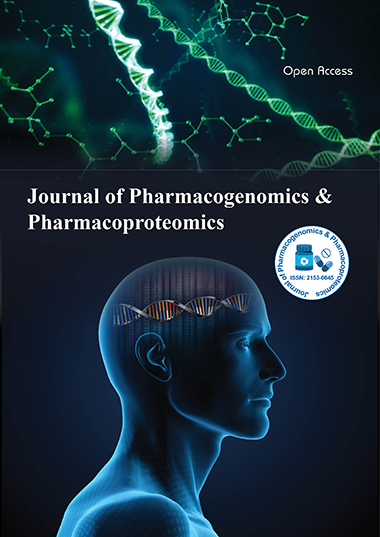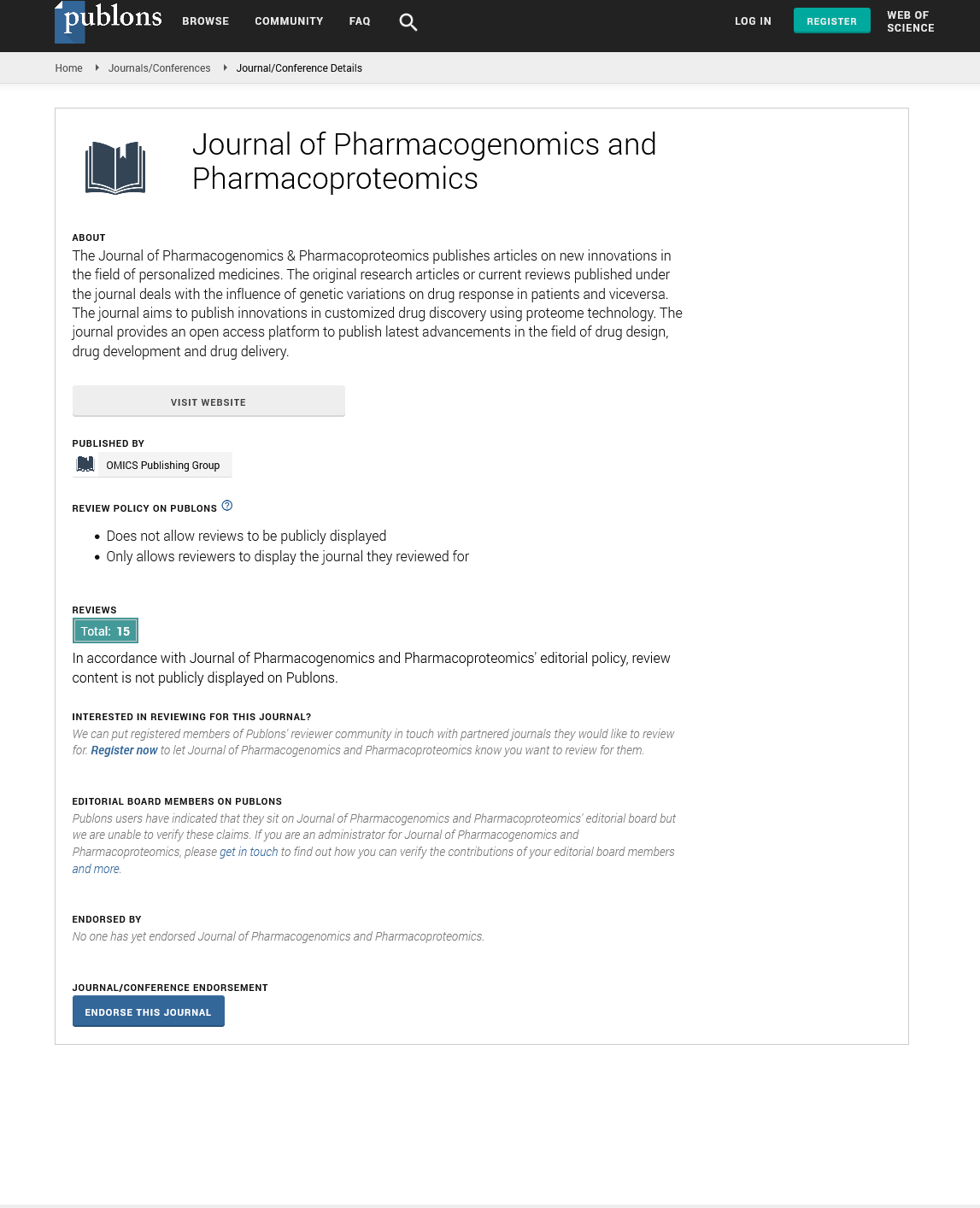Indexed In
- Open J Gate
- Genamics JournalSeek
- Academic Keys
- JournalTOCs
- ResearchBible
- Electronic Journals Library
- RefSeek
- Hamdard University
- EBSCO A-Z
- OCLC- WorldCat
- Proquest Summons
- SWB online catalog
- Virtual Library of Biology (vifabio)
- Publons
- MIAR
- Euro Pub
- Google Scholar
Useful Links
Share This Page
Journal Flyer

Open Access Journals
- Agri and Aquaculture
- Biochemistry
- Bioinformatics & Systems Biology
- Business & Management
- Chemistry
- Clinical Sciences
- Engineering
- Food & Nutrition
- General Science
- Genetics & Molecular Biology
- Immunology & Microbiology
- Medical Sciences
- Neuroscience & Psychology
- Nursing & Health Care
- Pharmaceutical Sciences
Commentary - (2024) Volume 15, Issue 1
VGLL4, Far More than a Tumor Inhibitor
Wei Yu*Received: 15-Dec-2023, Manuscript No. JPP-23-24422; Editor assigned: 18-Dec-2023, Pre QC No. JPP-23-24422 (PQ); Reviewed: 01-Jan-2024, QC No. JPP-23-24422; Revised: 09-Jan-2024, Manuscript No. JPP-23-24422 (R); Published: 17-Jan-2024, DOI: 10.35248/2153-0645.24.15.083
Description
The vestigial (vg) gene was first discovered in Drosophila and its homologues were subsequently identified in vertebrates and called Vestigial like member 1-4 (VGLL1-4) [1]. The VGLL proteins, act as transcription cofactor, interact with the transcription factor TEAD and MEF via a conserved TDU domain [2,3]. Among them, VGLL4 contains two TDU domains that can competitively bind TEAD with YAP, thereby inhibiting YAP downstream target genes and suppressing cell proliferation [3,4]. Therefore, VGLL4 is considered as a tumor suppressor and has been widely studied and reported [5,6].
To further explore the function of VGLL4, we constructed the first VGLL4 mutant mouse line and found that the VGLL4 total knockout mice died within 24 hours after birth [7]. Subsequently, tissue-specific knockout of VGLL4 was extensively investigated. We first found that specific knockout of VGLL4 in endothelial cells leads to excessive proliferation of interstitial cells after EMT transformation of heart valves in embryonic mice, resulting in valve thickening and ultimately abnormal cardiac function in adult mice [7]. Selective knockout of VGLL4 in muscle satellite cells significantly promotes their proliferation while inhibiting differentiation, leading to delayed muscle regeneration [8]. On the other hand, conditional knockout of VGLL4 in osteoblasts results in osteoporosis and a phenotype resembling craniofacial dysplasia due to osteoblast differentiation disorders [9]. Shortly after, another mutant mouse line exhibiting the same phenotype was reported, along with findings indicating that knockout of VGLL4 in mouse cardiomyocytes does not affect heart development [10]. However, the underlying cause of the postnatal lethality observed in VGLL4 knockout mice remains unclear.
In order to gain insights into gene function and the phenotype of gene mutations, it is often useful to investigate when and where a gene is expressed in the organism. One approach to determine the pattern and timing of gene expression is through the use of reporter genes which introduced upstream or downstream of the coding region of the gene, or through the conditional CreER/loxP (DreER/rox) system, in which tamoxifen induced CreER fusion protein excision of the loxP-flanked STOP (loxP-STOP-loxP) cassette upstream enables downstream reporter expression driven by ubiquitous promoter [11,12]. These regulatory sequences control which cells express a gene and under what conditions, and can also be used to drive the expression of a reporter gene. Therefore, we generated the Vgll4-GFP and Vgll4-DreER mouse lines. In the Vgll4-GFP line, the expression of the VGLL4-GFP fusion protein is driven by the endogenous Vgll4 promoter. The level, timing, cell location and cell specificity of GFP protein reflect the action of the VGLL4 [7]. As for the Vgll4-DreER line, which utilizes the Dre/rox system, it not only can be combined with a routine rox-STOP-rox-reporter cassette to induce the expression of reporter genes after tamoxifen administration, labeling VGLL4 expressing cells in vivo, but is also useful for combining with the CreER/loxP system and upgrade into a dual-recombinase system (such as loxP-STOP-loxP-GFP-rox-STOP-rox-RFP and loxp-STOP-loxP-rox-STOP-rox-RFP cassette and so on) to trace a specific VGLL4 positive cell population after introduce another cell specific CreER line, during development and pathological conditions [13,14]. Additionally, it also can be combined with the loxP-STOP-loxP-rox-STOP-rox-DTR-RFP cassette to delete specific VGLL4 expressing cell populations in vivo after tamoxifen and DT treatment, or to conditionally delete genes flanked by rox sites.
Our further application of the Vgll4-DreER mouse line may focus on two aspects. One is labeling and tracing specific VGLL4 positive cell populations during development, especially in the perinatal to postnatal stage, consistent with the results of Vgll4-GFP line, to disclose the postnatal VGLL4 expression map in different organs and pave the way to investigate potential postnatal lethality clues. The other is to observe the expression profile of VGLL4 under pathological conditions and to manipulate VGLL4 expressing cell population in vivo, and explore its function in diseases beyond tumorigenesis. We believe that the new function of VGLL4 will be reported successively in the near future.
References
- Kim J, Sebring A, Esch JJ, Kraus ME, Vorwerk K, Magee J, et al. Integration of positional signals and regulation of wing formation and identity by Drosophila vestigial gene. Nature. 1996;382(6587):133-138.
[Crossref] [Google Scholar] [PubMed]
- Maeda T, Chapman DL, Stewart AF. Mammalian vestigial-like 2, a cofactor of TEF-1 and MEF2 transcription factors that promotes skeletal muscle differentiation. J Biol Chem. 2002;277(50):48889-48898.
[Crossref] [Google Scholar] [PubMed]
- Chen HH, Mullett SJ, Stewart AF. Vgl-4, a novel member of the vestigial-like family of transcription cofactors, regulates alpha1-adrenergic activation of gene expression in cardiac myocytes. J Biol Chem. 2004;279(29):30800-30806.
[Crossref] [Google Scholar] [PubMed]
- Vaudin P, Delanoue R, Davidson I, Silber J, Zider A. TONDU (TDU), a novel human protein related to the product of vestigial (vg) gene of Drosophila melanogaster interacts with vertebrate TEF factors and substitutes for Vg function in wing formation. Development. 1999;126(21):4807-4816.
[Crossref] [Google Scholar] [PubMed]
- Zhang W, Gao Y, Li P, Shi Z, Guo T, Li F, et al. VGLL4 functions as a new tumor suppressor in lung cancer by negatively regulating the YAP-TEAD transcriptional complex. Cell Res. 2014;24(3):331-343.
[Crossref] [Google Scholar] [PubMed]
- Deng X, Fang L. VGLL4 is a transcriptional cofactor acting as a novel tumor suppressor via interacting with TEADs. Am J Cancer Res. 2018;8(6):932-943.
[Google Scholar] [PubMed]
- Yu W, Ma X, Xu J, Heumuller AW, Fei Z, Feng X, et al. VGLL4 plays a critical role in heart valve development and homeostasis. PLoS Genet. 2019;15(2):e1007977.
[Crossref] [Google Scholar] [PubMed]
- Feng X, Wang Z, Wang F, Lu T, Xu J, Ma X, et al. Dual function of VGLL4 in muscle regeneration. EMBO J. 2019;38(17):e101051.
[Crossref] [Google Scholar] [PubMed]
- Suo J, Feng X, Li J, Wang J, Wang Z, Zhang L, et al. VGLL4 promotes osteoblast differentiation by antagonizing TEADs-inhibited Runx2 transcription. Sci Adv. 2020;6(43).
[Crossref] [Google Scholar] [PubMed]
- Sheldon C, Farley A, Ma Q, Pu WT, Lin Z. Depletion of VGLL4 Causes Perinatal Lethality without Affecting Myocardial Development. Cells. 2022;11(18).
[Crossref] [Google Scholar] [PubMed]
- Srinivas S, Watanabe T, Lin CS, William CM, Tanabe Y, Jessell TM, et al. Cre reporter strains produced by targeted insertion of EYFP and ECFP into the ROSA26 locus. BMC Dev Biol. 2001;1:4.
[Crossref] [Google Scholar] [PubMed]
- Feil S, Valtcheva N, Feil R. Inducible cre mice. Methods Mol Biol. 2009:343-363.
[Crossref] [Google Scholar] [PubMed]
- Zhong Y, Tan X, Wang X, Jiang J, Song K, Chen H, et al. Generation of Vgll4-DreER transgenic mouse for visualizing and manipulating VGLL4-expressing cells in vivo. J Biochem Mol Toxicol. 2023;37(10):e23435.
[Crossref] [Google Scholar] [PubMed]
- Liu K, Tang M, Jin H, Liu Q, He L, Zhu H, et al. Triple-cell lineage tracing by a dual reporter on a single allele. J Biol Chem. 2020;295(3):690-700.
[Crossref] [Google Scholar] [PubMed]
Citation: Yu W (2024) VGLL4, Far More than a Tumor Inhibitor. J Pharmacogenom Pharmacoproteomic. 15:083.
Copyright: © 2024 Yu W. This is an open-access article distributed under the terms of the Creative Commons Attribution License, which permits unrestricted use, distribution, and reproduction in any medium, provided the original author and source are credited.

